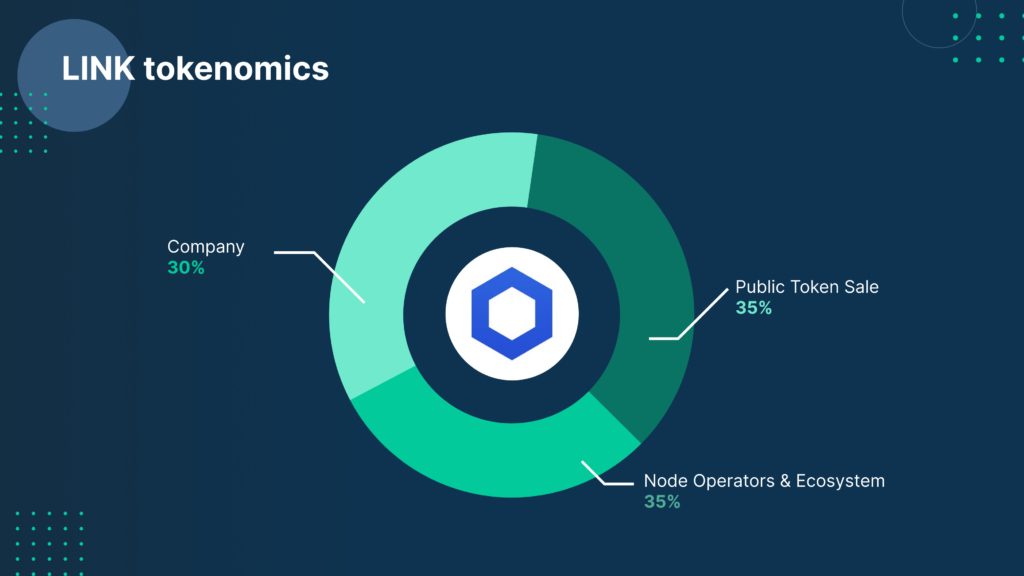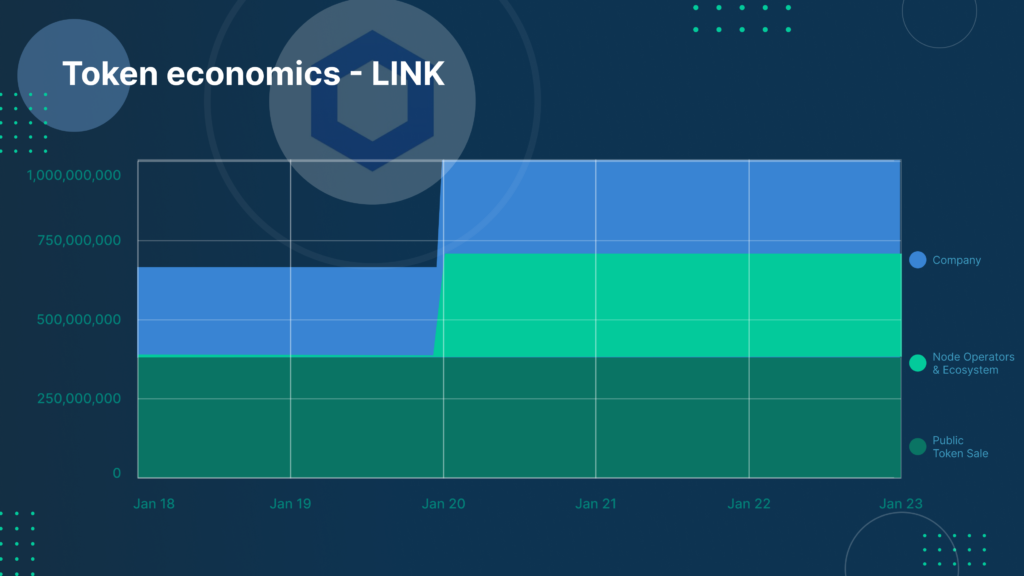The Chainlink network provides a secure and reliable way to feed this essential data into smart contracts, enabling them to execute based upon information like market prices, weather statistics, and other real-world inputs. Chainlink’s native token, LINK, is used to facilitate transactions within this ecosystem.
Chainlink
Chainlink is a decentralised oracle network, which plays a pivotal role in bridging the gap between external data sources and blockchain-based smart contracts. By securely and reliably feeding real-world data into these contracts, Chainlink facilitates complex, real-world interactions and transactions in the Web3 ecosystem.
Chainlink is preferred by many Web3 blockchains due to several key features that make it particularly well-suited for the decentralised and interoperable nature of these platforms. For instance, Chainlink is blockchain-agnostic, meaning it can function across multiple blockchain platforms. This interoperability is a significant advantage for Web3 projects that operate on different chains or require interaction between multiple networks.
Chainlink partners with numerous reputable data providers, ensuring that the data fed into smart contracts is accurate and reliable. This is critical for decision-making processes in decentralised finance (DeFi), insurance, and other sectors within Web3.
Chainlink has a robust and growing community of developers, users, and partners, fostering a rich ecosystem around its technology. This community support drives innovation and adoption, making Chainlink a go-to choice for many Web3 projects.
Chainlink’s ability to provide secure, reliable, and interoperable oracle services makes it a preferred choice for Web3 blockchains, enabling them to realise their full potential by interacting seamlessly with the real world.
How Chainlink Works
Chainlink’s process begins when a smart contract on a blockchain requires data from the outside world. This data could be anything from financial market prices, weather conditions, to flight schedules.
Chainlink’s network consists of node operators who are responsible for fetching this external data. These operators are incentivised (typically through LINK tokens) to provide accurate and timely data to the smart contracts.
Once a request is made, Chainlink nodes retrieve the necessary data from external APIs (Application Programming Interfaces). These APIs act as gateways to the required data from various off-chain sources.
After retrieving the data, Chainlink nodes aggregate this information to ensure its accuracy and reliability. They employ consensus mechanisms to filter out any anomalies or inaccuracies, ensuring that only the most precise data is used.
The aggregated data is then fed back into the smart contract. This data enables the smart contract to execute its coded instructions based on real-world inputs, which could be anything from triggering a payment to settling a financial contract.
Chainlink’s native token, LINK, is used within the network for payments to node operators for their services. It incentivizes them to provide accurate data and maintain the network’s integrity.
Chainlink allows developers to specify parameters such as which oracles to use, how many sources to gather data from, and how to aggregate the data. This customization ensures that the data is relevant and tailored to the specific needs of each smart contract.
Chainlink’s decentralised nature means that no single node can manipulate the data outcome. This setup adds a layer of security and reliability, as it reduces risks associated with centralised oracles.
Why is Chainlink Unique?
Chainlink’s primary innovation is its role as a decentralised oracle network. Unlike traditional oracles which are centralised and pose a single point of failure risk, Chainlink’s decentralised approach aggregates data from multiple sources, enhancing data accuracy and security.
Chainlink provides highly reliable and secure data feeds by sourcing information from numerous independent nodes and then aggregating it. This method minimises the risks associated with inaccurate or manipulated data, which is crucial for the proper execution of smart contracts.
Chainlink is designed to be blockchain-agnostic, meaning it can provide oracle services to multiple blockchains. This interoperability is key for the future of blockchain technology, as it allows for greater collaboration and functionality across different platforms.
By enabling smart contracts to interact with external data, Chainlink opens up a myriad of real-world applications. This capability is vital for sectors like finance, insurance, supply chain management, and many others where real-world information is crucial for automated contract execution.
What is the Chainlink Ecosystem?
Web3 Smart Contract Developers: Developers who build smart contracts on various blockchain platforms form a significant part of the ecosystem. They use Chainlink to feed external data into their contracts, enabling a wide range of functionalities, from DeFi applications to NFTs and beyond.
Data Providers: Reliable data sources are critical to the Chainlink network. These providers supply the real-world data that oracles relay to smart contracts. They include financial market data feeds, weather services, IoT networks, and more.
Node Operators: These are the parties who run the Chainlink nodes. They are responsible for retrieving, validating, and delivering data from external sources to the blockchain. Node operators are incentivized with LINK tokens to provide accurate and timely data.
What is the LINK Token?
The LINK token is the native cryptocurrency of the Chainlink network, playing a fundamental role within its ecosystem. LINK is an ERC-677 token, a standard built on top of the ERC-20 standard, which is widely used for tokens on the Ethereum blockchain. LINK is a utility token which fulfils the following use cases within the Chainlink ecosystem:
Incentive for Node Operators: LINK tokens are primarily used as an incentive for node operators in the Chainlink network. These operators are responsible for retrieving, validating, and delivering accurate external data to smart contracts on various blockchains. They are compensated in LINK tokens for their services.
Transaction Fees: Smart contract developers who need external data from Chainlink oracles pay for this service using LINK tokens. The amount paid depends on the demand for the data and the complexity of the request.
Decentralisation and Security: The use of LINK tokens helps maintain the decentralised nature of the Chainlink network. By compensating a diverse group of independent node operators with LINK, Chainlink ensures that no single entity can control the network, thus enhancing security and reliability.
Staking Mechanism: Staking in the Chainlink ecosystem offers participants the chance to gain rewards by enhancing the security and reliability of oracle services through the allocation of staked LINK tokens. The initial introduction of Chainlink Staking was marked by the release of version 0.1, and it’s set to advance further with the forthcoming version 0.2 upgrade.
Chainlink (LINK) Tokenomics


How to buy LINK with crypto
1. Log in to your Bitfinex account or sign up to create one.
2. Go to the Deposit page.
3. In the Cryptocurrencies section, choose the crypto you plan to buy LINK with and generate a deposit address on the Exchange wallet.
4. Send the crypto to the generated deposit address.
5. Once the funds arrive in your wallet, you can trade them for LINK. Learn how to trade on Bitfinex here.
How to buy LINK with fiat
1. Log in to your Bitfinex account or sign up to create one.
2. You need to get full verification to be able to deposit fiat to your Bitfinex account. Learn about different verification levels here.
3. On the Deposit page, under the Bank Wire menu, choose the fiat currency of your deposit. There’s a minimum amount for fiat deposits on Bitfinex; learn more here.
4. Check your Bitfinex registered email for the wire details.
5. Send the funds.
6. Once the funds arrive in your wallet, you can use them to buy LINK.
Also, we have Bitfinex on mobile, so you can easily buy LINK currency while on-the-go.
[ AppStore] [ Google Play]
LINK Community Channels
Website | Twitter | Discord | Reddit | Youtube | Telegram | WeChat | Kakao
The post appeared first on Bitfinex blog.

